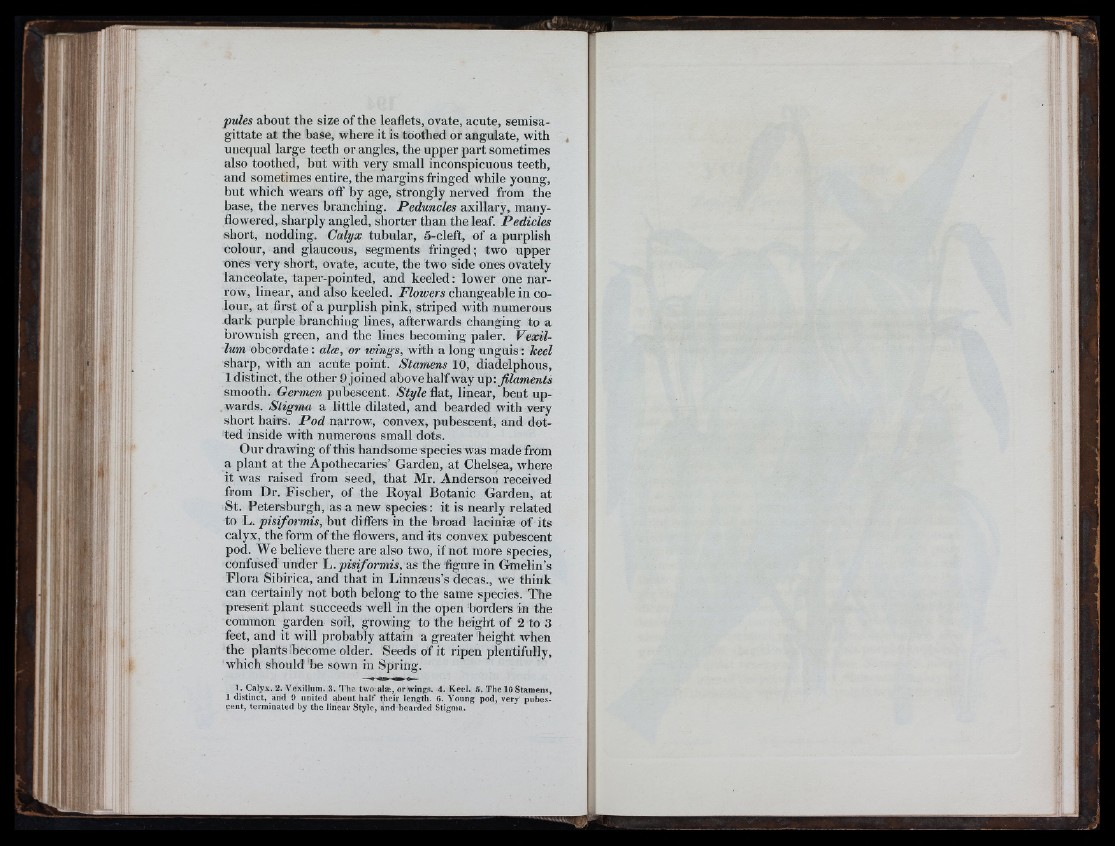
pules about the size of the leaflets, ovate, acute, semisa-
gittate at the base, where it is toothed or angulate, with
unequal large teeth or angles, the upper part sometimes
also toothed, but with very small inconspicuous teeth,
and sometimes entire, the ntargins fringed while young,
but which wears off by age, strongly nerved from the
base, the nerves branching. Peduncles axillary, many-
flowered, sharply angled, shorter than the leaf Pedicles
short, nodding. Calyx tubular, 5-cleft, of a purplish
colour, and glaucous, segments fringed; two upper
ones very short, ovate, acute, the two side ones ovately
lanceolate, taper-pointed, and keeled : lower one narrow,
linear, and also keeled. Flowers changeable in colour,
at first of a purplish pink, striped with numerous
dark purple branching lines, afterwards changing to a
brownish green, and the lines becoming paler. Vexillum
obcordate : alæ, or wings, with a long unguis : keel
sharp, with an acute point. Stamens 10, diadelphous,
1 distinct, the other 9 joined ahove halfway \\\>: filaments
smooth. Germen pubescent. Style flat, linear, bent upwards.
Stigma a little dilated, and bearded with very
short hairs. Pod narrow, convex, pubescent, and dotted
inside with numerous small dots.
Our drawing of this handsome species was made from
a plant at the Apothecaries’ Garden, at Chelsea, Avhere
it was raised from seed, that Mr. Anderson received
from Dr. Fischer, of the Royal Botanic Garden, at
St. Petersburgh, as a new species : it is nearly related
to L. pisiformis, but differs in the broad laciniæ of its
calyx, the form of the flowers, and its convex pubescent
pod. We believe there are also two, if not more species,
confused under V. pisiformis, as the figure in Gmelin’s
Flora Sibirica, and that in Linnæus’s decas., we think
can certainly not both belong to the same species. The
present plant succeeds well in the open borders in the
common garden soil, growing to the height of 2 to 3
feet, and it will probably attain a greater height when
the plants become older. Seeds of it ripen plentifully,
which should be sown in Spring.
1. Calyx. 2. Vexilhiin. 3. The two alæ, or wings. 4. Keel. 5, The lOStemens,
1 distinct, and 0 united about h a lf th e ir length. 6. Young pod, very piibe.s-
c e n t, terminated by the linear Style, and bea rd ed Stigma.